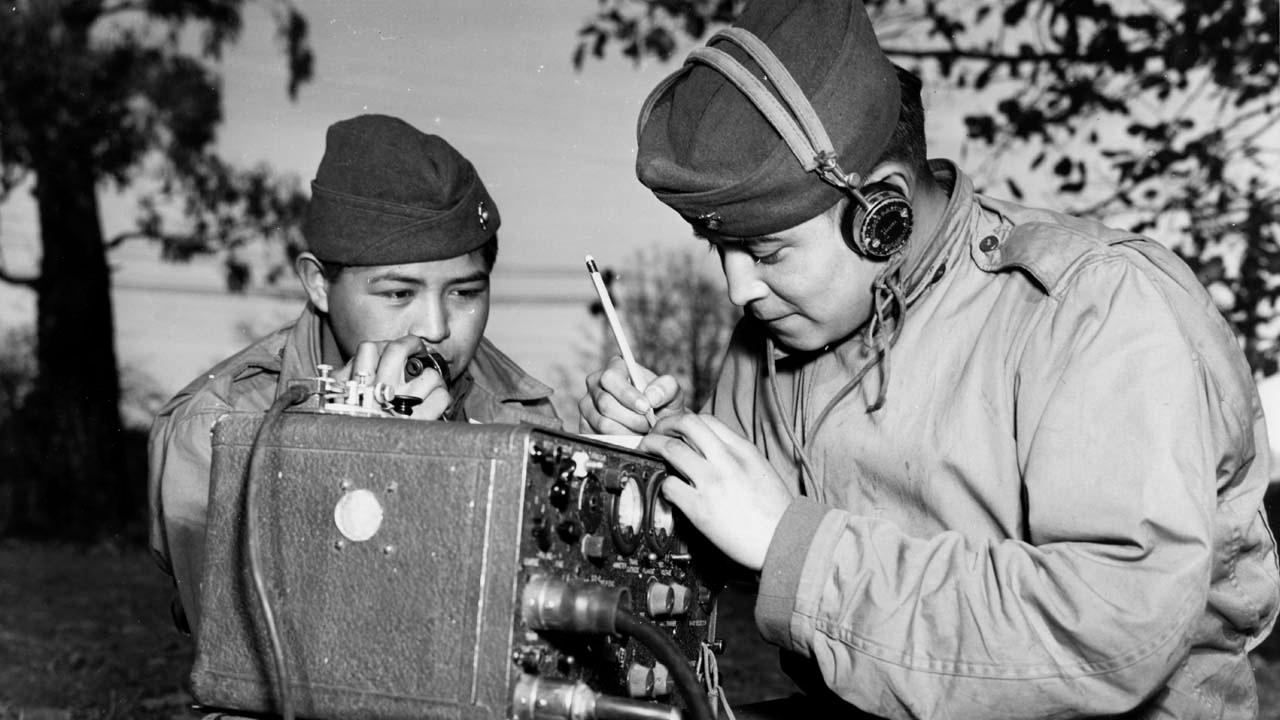
Reporting on Navajo Code Talkers
Middle and High School
4-5 Class Periods
Students will participate in a discussion about the historical context of Native American boarding schools, and the assimilation process. After watching segments from The Warrior Tradition, students will understand the importance of the Navajo Code Talkers. Groups of students will write and present a news broadcast about code talkers.
Program Segment
- Image of Native Americans and Stereotypes (approximately 18 ½ minutes)

The Warrior Tradition
Image of Native Americans and Stereotypes
18:29
Published:
Discover the diversity of Native American culture and how they have dealt with stereotypes
Objectives
Students will be able to:- Outline, summarize, and discuss the endurance of Native Americans in the progress of the United States.
- Explain the process of Native Americans put into boarding schools and stripped of their culture.
- Understand and explain the actions taken to assimilate Native Americans, along with the effects of that assimilation on Native American tribes.
- Explain the historical circumstances, as well as the importance of the Code Talkers in the success of the war in the pacific.
Instructional Resources
- The Warrior Tradition
- Candy
- Code Talkers Graphic Organizer
- Guidelines for news script

Procedures
4-5 CLASS PERIODS (break up where necessary)- As students walk into the classroom, have them turn in a personal item (cell phone/ear buds/ etc.).
- Direct all students to stand in the back of the room in a straight line.
- Direct the students who cooperated by turning in a personal item to go sit in a chair at a desk. As they are sitting, praise them and give them a piece of candy.
- The students who would not participate will be just told to sit down – without praise or candy.
- The teacher will initiate a class discussion by asking students:
- How did it feel when you were asked to hand in a personal item or something that is important to you?
- How did it feel when something you needed or part of you was taken away?
- All students should participate in the class discussion, even those who did not cooperate. They should reflect on why they did not cooperate. Students who did hand an item in, can reflect on how that felt.
- The teacher will ask students what they know or believe about Indian Boarding Schools, to check for prior knowledge. The teacher can summarize what the students will see in the segment from The Warrior Traditionthat they are about to watch.
- The teacher will then engage students in another classroom discussion, asking:
- What does culture means to you?
- Why it’s important to preserve culture?
- What is “assimilation?”
- What assimilation do you notice around you in your family, class, school, or neighborhood?
- The teacher should explain in detail the historical context of Native American boarding schools, and the assimilation process, then distribute the Code Talkers Graphic Organizer.
- Students will then watch the segment of The Warrior Tradition based on the Navajo Code Talkers. They will fill in the Code Talkers Graphic Organizer while watching it.
- The teacher will assign groups of 2-3 students to create a script for a news broadcast based upon the Code Talkers.
- The teacher will set up the classroom to appear as a news station for students to present their script. The students will present their script to the class in the role of a news anchor.
Assessment Tasks
- Students should actively participate in all the classroom discussions.
- Students will turn in a completed Code Talkers Graphic Organizer.
- Groups of students will turn in a news script.
- Students will present their news reports to the class.
Extension Activities (optional)
- The Code Talkers news broadcast, can be video recorded and uploaded to the teacher's website.
- A website can be created solely for the news broadcasts.
- In place of the news broadcast, students may create a blog or a news story article.
National Curriculum Standards for Social Studies – Thematic Strands
- Culture
- Individual Development & Identity
- Individuals, Groups & Institutions
- Power, Authority & Governance
- Civic Ideals & Practices
